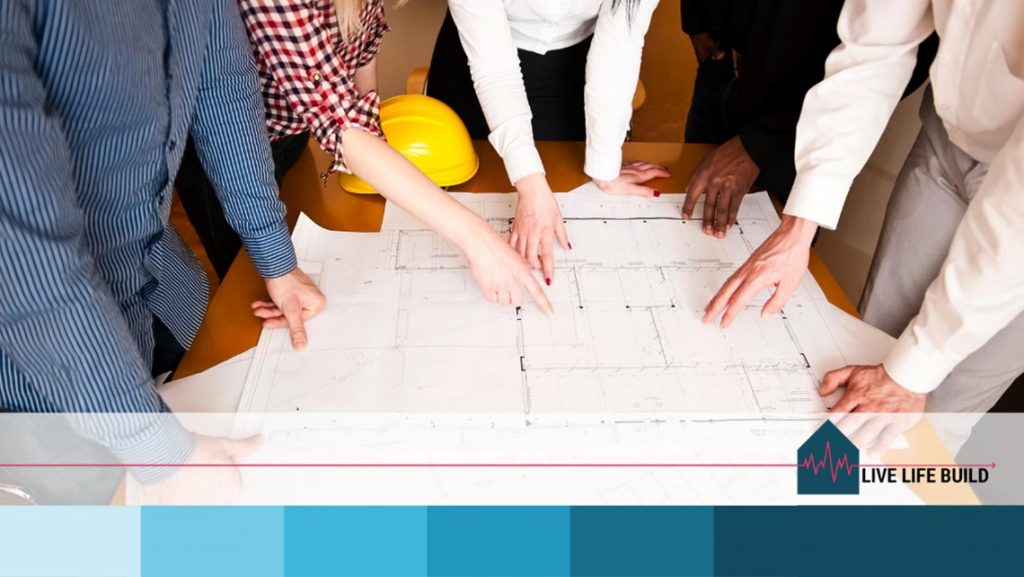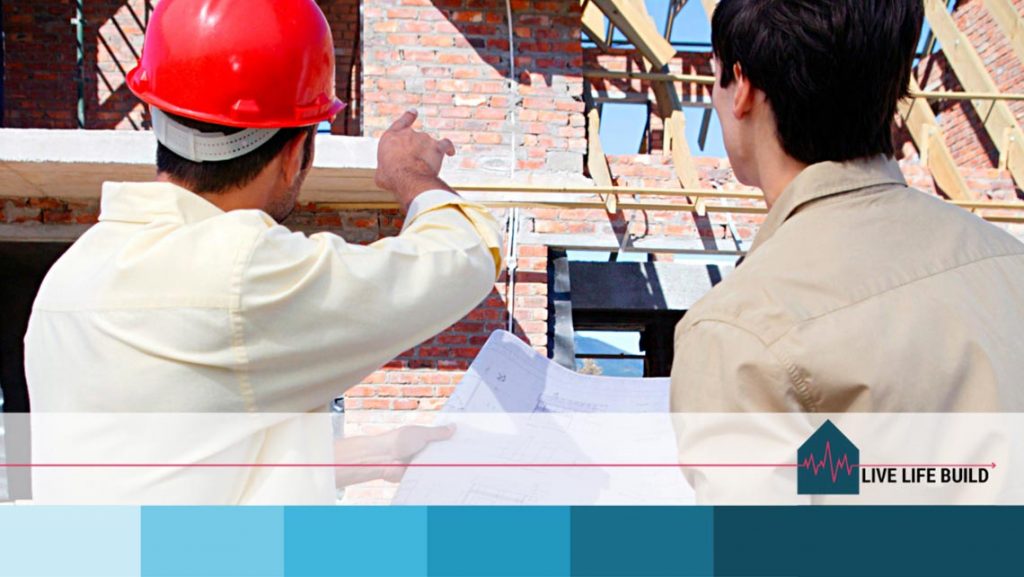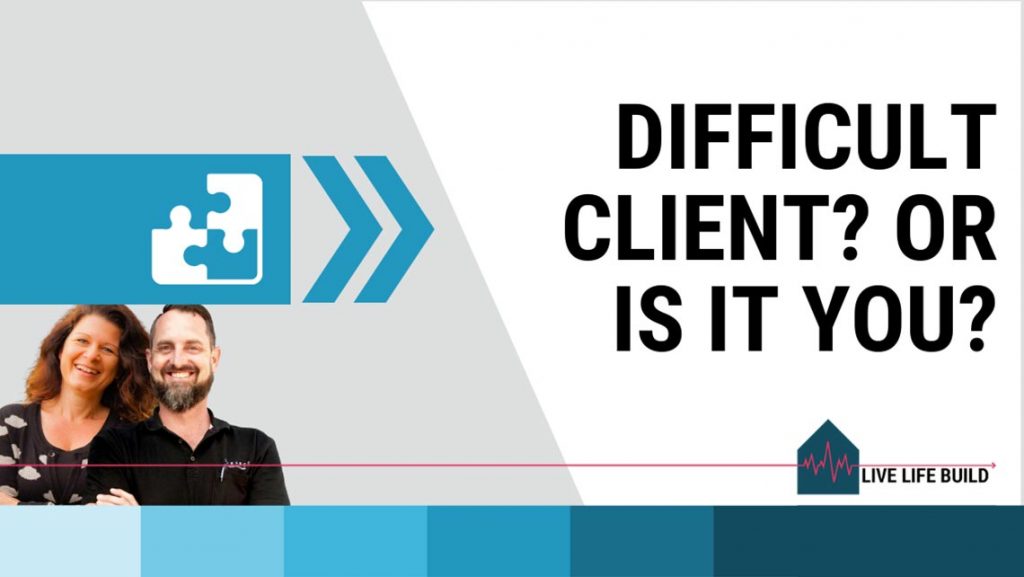Do you have a difficult client?
Are you looking forward to the day of not having to work with a difficult client ever again?
Creating great client partnerships is key to a successful thriving business, unless you plan on only doing your own developments!
In this blog post, Amelia shares her own experience of working with builders and clients, and gives some tips on how to improve your relationships with clients.
Plus, Amelia also shares some specific things to understand about who your client really is, and how to best support them in their project.
Read on here …
5. DIFFICULT CLIENTS: DO THEY EXIST?
Many builders who are not having a great time in their businesses, will speak about their desire to do their own developments in the future. This is because they look forward to doing their own projects, where they don’t have to deal day-to-day with clients, and can simply build what they want to build.
And yet, doing your own developments as a builder can be challenging. Seeking finance as a self-employed business owner requires a solid financial foundation, and it can take a lot to make it happen.
And in the meantime, you’ll still be working with clients – and complaining about them.
How about you instead figure out if your clients are really as difficult as they seem to be?
Difficult clients rarely exist. That’s right!
“Ha ha”, you say, “you haven’t met my latest clients!!”
And yes, we know there can be clients who behave like bullies. Or who are pedantic and on the phone or email all the time. Or who say something one week, and change their mind the following week. Or who flare up angrily if they feel slightly put off-side by you. Or who act like the expert and question everything you do.
However, what’s really behind all of this?
This may sound a little woo woo, but the truth of the matter is that we all choose to operate from one of two places. Love. Or fear. And under every emotion expressed in any situation, it’ll be one of those two feelings at the core of it.
More often than not, a difficult client is actually a frightened client. An angry client is a frightened client. An indecisive or ‘annoying’ client is a frightened client.
For most clients, they enter the building and renovating process like this. They’re:
- likely to have unrealistic expectations of what their project will cost or how long it will take
- unsure of the process of building or renovating their home
- nervous about spending money they’ve worked very hard for, or will be paying off for a long time
- overwhelmed by how much is involved
- unsure if they can trust you (because you could be dodgy like so many others are)
As builders and those in the industry, we actually have a responsibility to help our clients not be frightened in their projects. And the way we can do this is by:
- educating them about the process
- demonstrating our authority and reliability in real and tangible ways
- listening to them
- doing what we promise to do
- managing their expectations
The client isn’t the expert. You are.
If they’re frightened, it’s usually because they don’t have enough information. About their project. About you.
So, help them feel informed. Meet them where their needs are at. And then be upfront about what you’re like to work with, so you can manage their expectations and set the rules for engagement.

4. WHO IS YOUR CLIENT (REALLY?)
The industry of residential renovations and new builds is much like any other retail industry, in that women make the bulk of the purchasing decisions.
In fact, research shows that when it comes to renovating and building, women make – or heavily influence – over 80% of the purchasing decisions.
As a female architect, I’ve worked with loads of different clients. For those who are in a couple, I’ve found that it doesn’t really matter what their occupations are, who is working full time and who is not, and how their family is set up.
More often than not, it’s the female that has thought intensively about the project, has a strong vision for what they want, and is the one managing the interactions and driving the project from the client-side.
And yet, I also know that many couples have had this experience with their builder:
- The builder, when speaking to the couple, mainly speaks to the husband or male partner throughout their interactions
- An issue will come up where the builder needs a decision on something
- The female partner wants more time to research her decision, check some options, and understand the consequences
- The male partner is able to instead discuss things quickly and frankly, just wants to talk about it less and have the decision made
- The builder moves along the conversation that way as well
- The female feels left out of the conversation, the decision, and ultimately her project
- And trust is broken between the builder and the female partner
And then, more often than not, the builder will get a call a day or so later from either party saying there’s been a change of mind. What’s really happened is that the female has had the time to think about and review things, and shown the male that the best decision wasn’t made in the moment.
So, as a builder – who is your client really?

3. WHO IS REALLY RESPONSIBLE?
Many builders blame their clients for the difficulties they have in their projects and when their relationships go pear-shaped over the course of a renovation or new build.
However, as Bob Marley said “Before you start pointing fingers, make sure your hands are clean!”
You’ll get a lot further in creating the projects you want, and the types of partnerships you’d like to foster, if you take responsibility for what you can change.
So, here are some questions to ask yourself that can identify areas of improvement and potentially transform the relationships and partnerships you create with your clients.
Q: How are you setting up your communication to ensure your clients feel heard and listened to?
Do you have ways in your business to collect feedback and project discussion from your clients so you understand their wants and needs, and can clearly identify how you’ll help them be delivered in your work with them?
Q: What are you doing to manage expectations with your clients so they always know what it’s like to work with you?
Do you have a method to explain to clients (right from the start) how you work, and what it involves, so they can know what to expect from you? And do you continue this throughout your projects using specific and regular methods of communication so they always feel informed and understand what’s happening in their project?
Q: Do you have systems and processes in place that facilitate easy communication with your clients?
Do you outline what systems and processes you’ll be using from the outset of your client relationship? Do you have regular meetings with them where they can discuss their concerns? Do you handle their queries and concerns in a professional way that helps them feel reassured and confident in your abilities?
Q: Is your communication with clients open and proactive?
Do clients feel they can discuss anything with you? Do you let them know that there’s no such thing as a silly question, and you welcome all communication? Do you help your clients feel at ease and comfortable that they can discuss any concerns with you, and that you have a solutions-focused approach anytime a problem comes up? And are you proactively getting in touch with your clients if anything changes in their project, or you need to communicate with them?
Q: Do you have females on your team that can help you with relating to your female clients? And do you have rules and expectations for your whole team in how they relate to female clients?
I recall seeing in a Facebook group recently that a woman had a tradie come to do a job at her home.
She said she was relatively friendly to him, offered him a cup of tea, and had a general chat. It was nothing out of the ordinary for someone in her home.
However, the tradie, as he left, asked her if she’d like to go for a drink sometime. She said ‘no thanks’ and tried to laugh it off. He said that he had her number and might give her a call sometime in case she changed her mind.
She was sharing how fearful she was. She’d said ‘no’ to this man, and he’d not listened. And now he knew where she lived, had her number and knew she lived alone.
Whether you agree with her reaction or not, that’s not the point.
Situations such as this are a HUGE issue for women working with builders and tradies, who don’t feel safe and secure. As a younger female (and architect), I personally experienced many instances of feeling unsafe on building sites, or walking past building sites, and male tradies behaving a certain way.
So what rules do you have for your team in how they interact with your clients? And how do they represent your business?

2. DIFFICULT CLIENT? OR DIFFICULT CONVERSATION?
Having worked with thousands of homeowners over the years, one thing they regularly tell me – especially women – is this:
“I’m not a confrontational person. I don’t like confrontation. I find it difficult to speak up at times when I disagree with something. I’d much rather keep the peace.”
This can mean that clients don’t bring up their concerns or issues, but instead stew on them quietly, discussing them with their friends (or worse, Facebook groups). Molehills become mountains, and very quickly, something that was quite small can accelerate into a BIG issue and working relationships deteriorate as a result.
I find, too, that builders can often be fearful of having a difficult conversation with clients, and will delay discussing with them anything that might upset them.
Sometimes this means builders will just do variations without getting formal sign off (which is contractually wrong). Or they’ll avoid bringing something up until the last minute, which then can make a client feel pressured and stress in their decision-making.
This combination of clients who don’t want to confront issues when they happen, and builders who don’t want to confront issues when they happen, can really make for a terrible project experience.
What I teach homeowners is that speaking up about situations as they happen isn’t a confrontation. You can have difficult conversations without being confrontational. And you can cultivate a relationship with your builder that keeps the lines of communication open, where feedback isn’t taken as a personal attack, and your project is king (or queen) in all dealings.
As a builder, it’s worth remembering that homeowners want you to lead them, to guide them and to be open with them. Having a difficult conversation where you’re stressed about the consequence is sometimes necessary in building a great relationship with your client.
We recently had one of our Live Life Build ELEVATE members talk about this in our regular catchup. He had reviewed the price increases on three projects, and knew that he needed those price increases onto the clients. That meant having a difficult conversation and being honest about the situation: what the price rises are, his numbers and his inability to proceed with the projects if they couldn’t reach a resolution.
You know what? All the clients understood. And agreed to the increased prices in their projects. Imagine if he hadn’t stepped up to that difficult conversation at all?

1. GETTING THE RELATIONSHIP BACK ON TRACK
As with any relationship, things can go pear-shaped. The relationship you create with your clients is an intimate one involving their family, their lifestyle goals, their finances and a lot of time. As an architect, I’ve joked that I know where my clients keep their underwear! I also know how they’re funding their projects, and what that means for them financially over the long-term. It’s a really personal and close relationship.
And like any close relationship, things can go off track. There can be disagreements, and challenges that make things hard during the course of a project.
The key is to get things back on track as quickly as you can, so as to ensure you can keep progressing. Or to terminate things if they’re irreversibly damaged (and know your legal obligations in the unlikely event of that worst case scenario).
Letting bad relationships drag on and on is far more damaging to your projects, business and personal well-being, than navigating what’s required to overcome the challenges.
Here’s some tips for trying to repair any issues:
- Avoid accusing your client of things. Avoid even using ‘you’ in the sentence (such as ‘you were supposed to do this’). Instead, talk about it from your own point of view. “I was expecting it would be like this”.
- Don’t make it personal. Don’t bundle in character slander or criticism of who they are. You’re a business. They’re your client. Whilst you’re creating their personal home and dealing with them personally, this IS a business transaction first and foremost.
- Remain professional. Refer to your written agreements and requirements as a professional builder. This may feel formal, however if you have systems and processes in place, use them and point to them.
Most damage control in any client relationship actually happens BEFORE you get to the issue. If you’re managing expectations, establishing the rules for your projects, and following through on what you promise, you’ll find you avoid a lot of drama.
It’s when you let things slip and slide in small amounts that those issues gain momentum into bigger problems.
Your partnership with your clients can be one of the most enjoyable parts of your business if you set it up for success. It can mean that you’re working with people who respect you, and you respect, and who share your values, and really love having you on their team. Clients like this can become amazing ambassadors for your business, and help others like them find you to work with.
Investing in creating great partnerships with your clients is a business investment worth making.

So, here’s our 5, 4, 3, 2, 1 to identify your ideal project.
5. Have you asked your team what their goals are?
4. How can you help and facilitate your team’s goals?
3. What are your goals as a team?
2. Holding people accountable.
1. Celebrate the wins and create a good work environment.
Live Life Build’s 6P Methodology unlocks the 6 ways to elevate your building business:
PERSONAL | PROJECTS | PEOPLE | PARTNERSHIPS | PROCESSES | PROFESSIONAL
Want to learn how to be a better business owner? Learn the systems, marketing tools, mindset and business skills you need in our group program and mastermind, ELEVATE. Learn more here.

